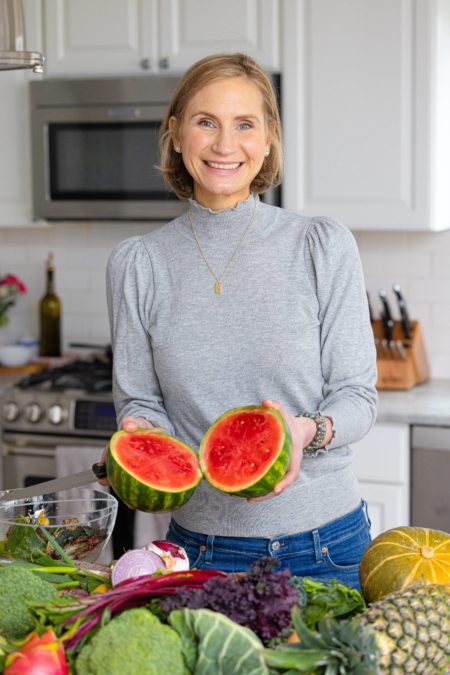By Dr. Katie Takayasu

Getting back into the swing of things after a summer of flexible schedules, vacations, and excuses to drink rose can be a challenge to our internal sense of balance for all ages. As an Integrative Medicine MD who believes in the power of lifestyle, here are my top 3 ways to restart your wellness this fall.
1. Prevent blood sugar crashes with macro-balanced meals
Every time you feed yourself, make sure you have a balance of fiber, fat, and protein. This is key to freeing yourself from counting calories, unplanned weight gain or loss, insurmountable cravings, energy ups and downs, or feeling unsatisfied after eating.
Protein provides nutrients to build and support your bones, muscles, and connective tissues. Animal sources are efficient forms of protein because they are complete proteins, meaning they have all of the essential amino acids we can’t make in the body. There are a few plant-based proteins that are complete too, including quinoa, edamame, tofu, and tempeh. If you’re eating some animal protein along with lots of plant-based protein, you’ll get the amino acid balance you need. I advocate for making at least one meal a day completely plant-powered, relying on proteins from lentils, legumes, whole organic soy, nuts and seeds. Protein needs per pound of body weight are highest for growing kids and for those over the age of 65.
Fat in the diet does not make us fat. I’m a proponent of a good, healthy dose of fat at every meal and snack because it’s satiating and tastes good. Not all fat is created equal. Prioritizing healthy monounsaturated fats in avocado and olives (and their oils) and omega-3 fats found in wild salmon, halibut, herring, and sardines is a good idea. The anti-inflammatory effect of omega 3s stretches across multiple organ systems, including promoting cardiovascular health; protecting the brain from Alzheimer’s, dementia, ADHD; mental health including management of depression and anxiety; and prevention the disastrous combination of high blood pressure, high triglycerides, and elevation in blood sugar.
Carbohydrates provide the most available energy to our bodies and come in the form of sugars, starches, and fiber. Fiber is present in all plant-foods in varying amounts. Think about fiber like fertilizer for your helpful gut bacteria. It supports regular bowel movements, prevents plaque formation, and anchors your appetite and blood sugar by slowing down the rate at which carbohydrate sugars are released into your bloodstream thus keeping you full. Aim for 30-40 grams of fiber each day
Your goal is to keep your blood sugar even throughout the day with slow burn carbohydrates in combination with fat and protein to prevent the ups and downs in your blood sugar that trigger weight gain, energy crashes, cravings, mood swings, and feeling “hangry” (a disastrous combination of being angry because you’re hungry).
2. Move your body every day to encourage energy and concentration
Exercise is my favorite feel-good pill.
Exercise has been directly connected to reducing risk of high blood pressure and cardiovascular disease, insulin resistance and diabetes, osteoporosis, cancer, dementia, Alzheimer’s, and loss of muscle mass (sarcopenia), as well as a direct decrease in body-wide inflammation. However I tell patients the best reason to exercise is the production of feel-good hormones called endorphins. Multiple studies show moderate exercise like walking is just as effective as using SSRIs in the treatment of depression and anxiety. Additionally exercise is helpful for improving concentration, especially for those who struggle with ADHD.
I recommend 7,000-8,000 steps spread throughout the day. I’m sure you’ve heard the phrase, “Sitting is the new smoking.” American adult desk workers can sit up 15 or more hours per day, and recent evidence makes a persuasive case that too much sitting should be considered a stand-alone component of calculating future risk of diabetes and cardiovascular disease.
It’s also important to work on balance and strength, especially to promote healthy muscles and bones. Most osteoporotic fractures happen because people are not as strong or stable as they could be. Do yourself a favor and start your muscle building now to improve your functionality and promote independence as you age. Aim to do at least two strength building sessions per week.
3. Make time to relinquish to rest by establishing a bedtime routine
Sleep makes almost everything better. It’s a magic pill that decreases inflammation and susceptibility to infections, regulates your hunger and satiety hormone signals, decreases risk of heart disease, diabetes, and cancer, encourage proper growth through childhood and adolescence, makes you more pleasant and less irritable, and improves your cognitive and physical stamina.Taking time for adequate rest is one of the best things you can do for your body, as it’s the time our bodies use to heal, detoxify, and recharge our systems.
You can’t make yourself fall asleep. It’s something that happens to you, something you relinquish to. This idea of letting go and relinquishing to rest is important, especially if you are go-go-go all day. I find that most of my patients with sleep issues are not insufficiently sleepy, but actually excessively awake, a “tired but wired” feeling. It’s virtually impossible to fire on all cylinders from the time we wake up in the morning until the moment our heads hit the pillow.
The mind and body need a wind-down period at night, an opportunity to settle and ground after a full day of learning and experiences. I recommend giving yourself 45 minutes to come down from the day. This wind-down period needs to be device-free to avoid blue-light stimulation (which stimulates rather than relaxes the brain), and generally could include any number of relaxing activities, including a warm bath with magnesium salts, a cup of chamomile tea, a non-stimulating book, restorative yoga, prayer, or meditation.
Most adults need seven to nine hours of sleep per night, with kids needing even more: as much as 16 hours for infants to 10 hours for adolescents. The best way to know your individual need is to remember back to your 20s and think about how much sleep you needed to feel great. There’s your answer.
It’s important not to shortchange your sleep, especially for teenagers who are likely to stay up late studying or hanging out with friends, though almost all of us engage in social jetlag on the weekends with staying up late and sleeping in. In the first part of the night, our brains are pruning connections, deciding what information should be kept. In the latter half of the night, our brains are strengthening and storing those memories so that we can call upon them later. If we stay up late watching TV, we miss out on the pruning. If we wake up early to catch a morning flight, we miss out on the storing.
There are many entries into living a full, authentic life, and this was a quick primer on how to build fertile soil with meaningful lifestyle choices.
If you’ve enjoyed this article, visit me on Instagram @doctorkatie, with my book Plants First, and at www.DrKatie.com to learn more about my Integrative Medicine practice Wellness Insights in Darien. Join me for our upcoming September 20 Masterclass on Kid-Friendly Strategies to Enhance Learning in the School Year, or reset with our effective Dr. Katie Detox complete with meal delivery this fall.
Dr. Katie Takayasu is an Integrative Medicine physician, author of Plants First: A Physician’s Guide to Wellness Through a Plant-Forward Diet, and speaker in the holistic health space. She helps people connect to wellness using the tools of nutrition, acupuncture, meditation, botanicals and lifestyle optimization. She works one-on-one with patients in her collaborative healing center Wellness Insights in Darien, and in group settings with the gentle but effective Dr. Katie Detox, a jumpstart to reclaiming wellness and lifestyle balance by harnessing the body’s natural wisdom for detoxification. She loves being with other people who bring her joy, especially her husband and two sons. Discover Dr. Katie’s Life Kitchen at www.DrKatie.com or on Instagram @DoctorKatie.



